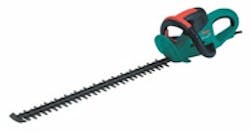A line of powerful hedge trimmers from U.K.-based Bosch needed a clutch mechanism that could disengage the oscillating blade if the operator took his hands off the grips. And when engaged, the clutch had to supply enough torque to cut through thick branches without slipping. The mechanism also had to protect drive gears if the trimmer hit something tougher — like a chain link fence.
Bosch turned to a compact mechanical clutch from Reell Precision Mfg. Corp., St. Paul, that is based on wrap spring technology and includes a builtin constant-torque slip device. Wrap spring clutches quickly and consistently engage and disengage — even under heavy loads. Inside, a coil spring rotates with the drive motor. The output shaft, or driven part, is located down the center of the spring’s coil. If the spring’s tail is moved opposite the direction of its windings, the coil expands and disengages the output shaft. If the tail is allowed to relax, the coil shrinks and grabs the shaft, transferring rotation to the output.
The trimmers are powerful tools that generate more than three-quarters of a horsepower. The motor constantly spins at about 25,000 rpm and is geared down to turn the clutch at 1,500 rpm. Acting like an on-off switch, the clutch engages the blades when the operator grips the handles with both hands. If the trimmer hits something it can’t cut through, the blades stall instantly. But because the motor’s armature spins at 25,000 rpm, it has a lot of kinetic energy in the form of momentum. The built-in slip device lets the kinetic energy dissipate over about a half revolution of the clutch, safely slowing and stalling the motor.
